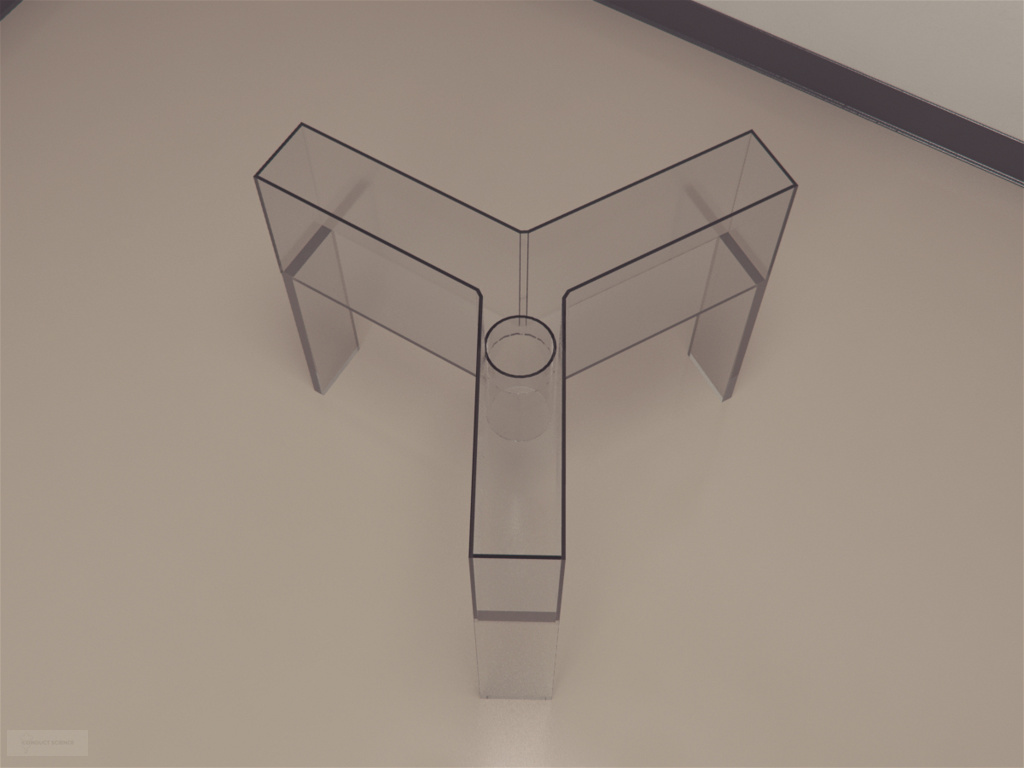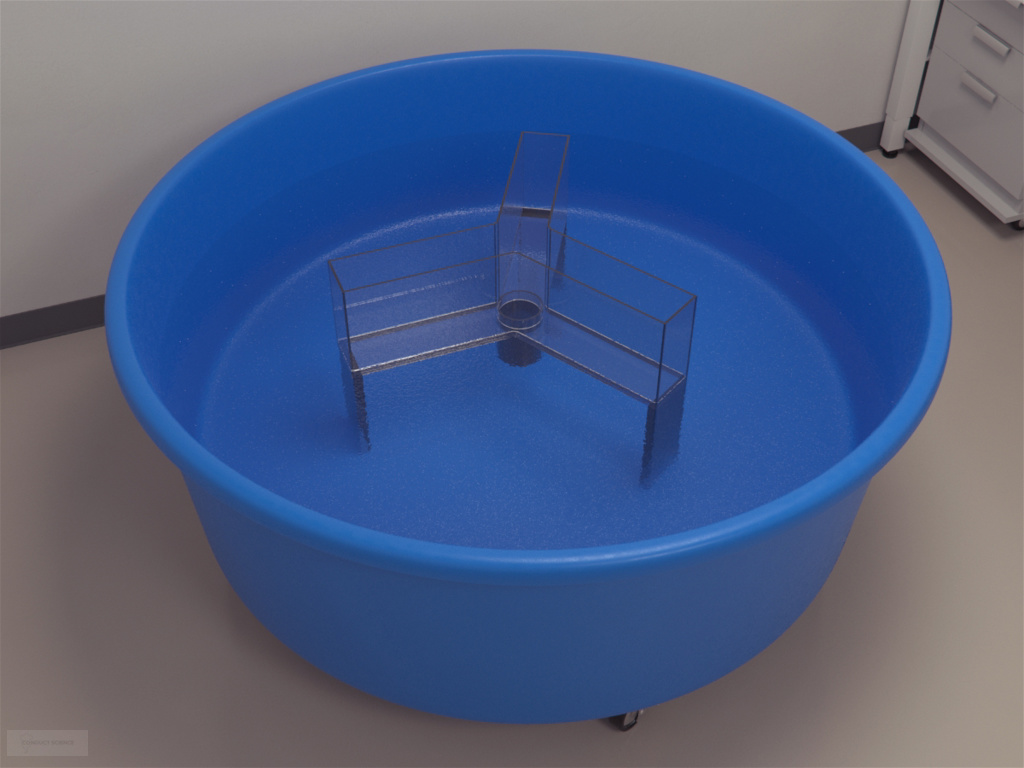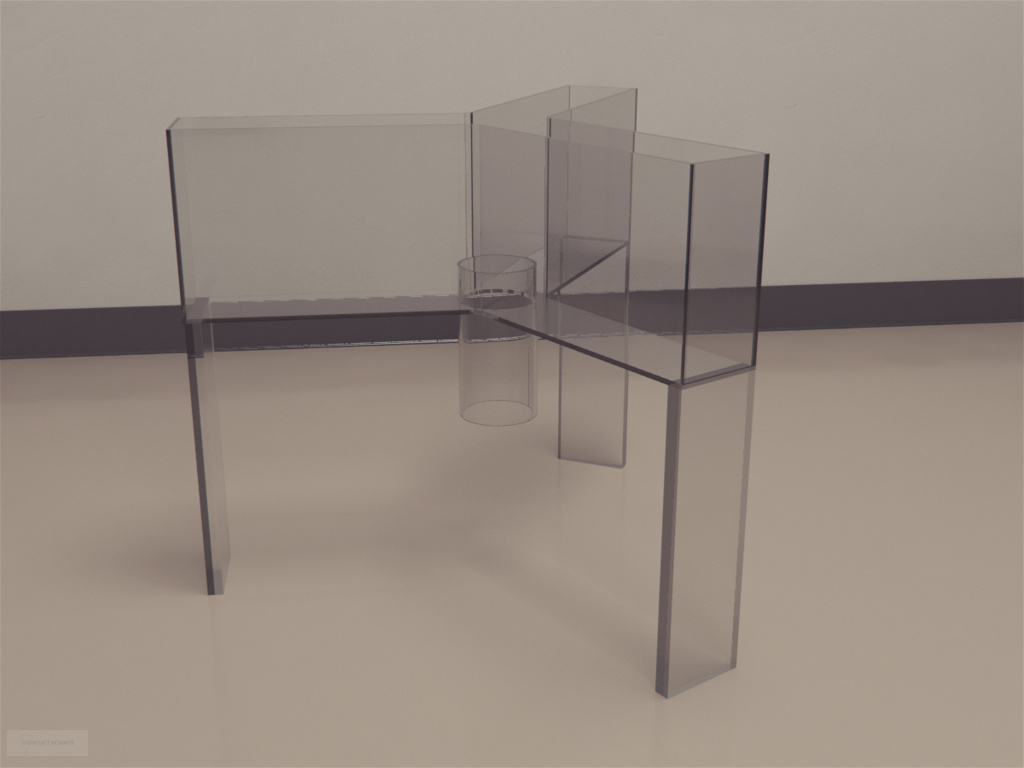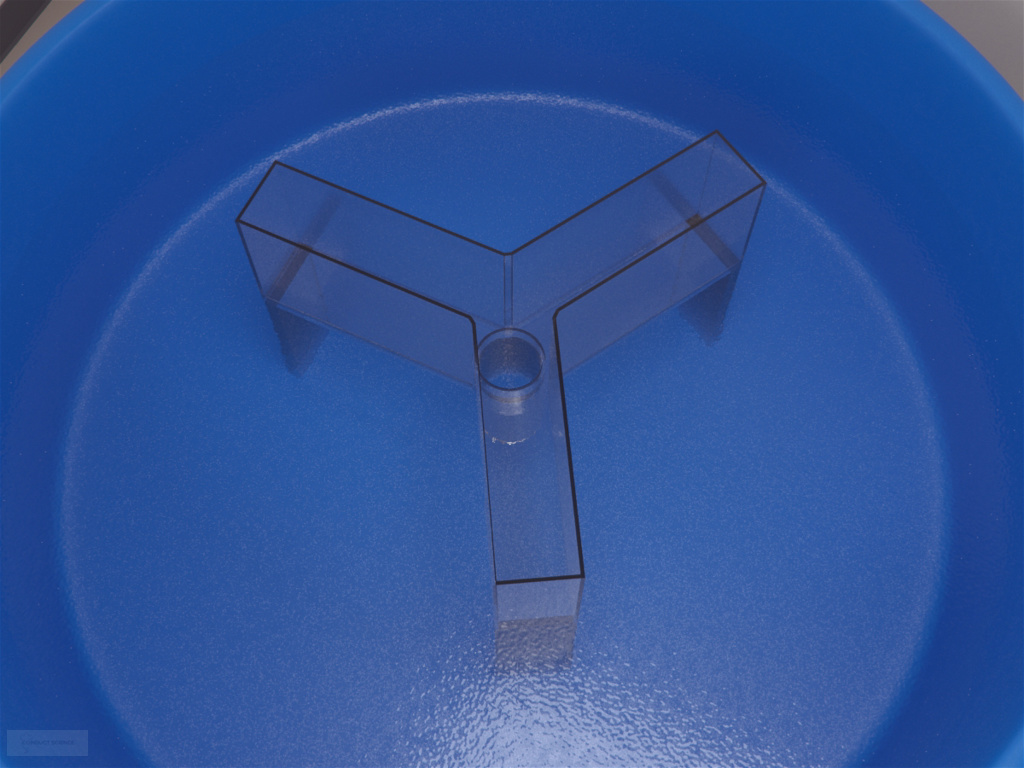The Octopus 3 choice Maze consists of a narrow central tube opening into three choice compartments and was based on the natural probing movement which octopus arms often perform when exploring and hunting in small crevices and under rocks.
A black disk in the goal compartment visually marks the presence of a small piece of food, which is moved between choice compartments in a random sequence. In order to reach the food reward, octopuses have to reach a single arm through the tube, out of the water (thus preventing chemical cueing), and into the water of the goal compartment.
Mazeengineers offer Octopus 3 choice Maze. Custom coloring and customization are available upon request.
Price & Dimensions
Octopus 3 Choice maze
$ 1690
+S&HDocumentation
Introduction
The Octopus 3-Choice Maze was developed to answer the question if octopuses are capable of relying only on their vision to make a correct choice. The highly flexible, multi-limb creature has had researchers question their ability to combine visual control of their limbs with central nervous system reward information. In fact, it has been argued that octopuses lack the computing mechanism to control their kinetically hyper-redundant arms in an environment that presents an abundance of multisensory inputs (Wells, 1978). The Octopus 3-Choice Maze was developed by Gutnick, Byrne, Hochner, and Kuba (2011) to explore this theory.
The maze forces the cephalopod to make use of only a single arm to access the reward. Additionally, the maze requires the subject to reach the goal arms through the air, thus eliminating dependence on chemical cues. Commonly, the Octopus 3-Choice Maze is a clear apparatus used to evaluate vision-based maze solving behavior by the placement of a visual cue in the rewarded arm. However, its opaque counterpart can be used to establish the use of vision in maze-solving further. The maze can also be applied in the assessment of preferences and other learning and memory tasks.
The Octopus 3-Choice Maze has a central vertical arm that connects the holding tank to the choice compartments. This vertical arm does not have any water present in it to prevent the subject from relying on chemical cues. The vertical arm opens up to three water-filled choice compartments that house visual cues in addition to rewards. Other apparatuses also used in behavioral assessment of octopus include the Octopus Round Arena and the Octopus Y-Maze.
Apparatus and Equipment
The octopus 3-Choice Maze is made of clear acrylic to allow visual interaction. The maze consists of a vertical cylinder that links the holding arena with the choice compartments. The vertical cylinder is wide enough only to allow one arm of the cephalopod to explore the maze. The vertical arm opens up to three choice compartments that are perpendicular to it and are equally spaced from one another. The choice compartments can be filled with water up to the extended height of the vertical arm.
Training Protocol
Ensure the apparatus is cleaned between use to prevent the influence of any lingering stimuli on the maze performances. Appropriately illuminate the testing area. The scoring of behavior can be assisted by an automated tracking and recording system such as the Noldus EthoVision XT.
Pretraining
Following habituation to new conditions and the presence of people, begin pretraining sessions once every two days. Place a clear tube, identical to the vertical tube of the maze, in the tank. Using a pair of forceps, hold a bait within the tube and lure the subject to take it. Once the subject is comfortable with the tube, place the tube halfway above the water to encourage the subject to guide its arm out of the water in order to obtain the food. Following acclimation to this process, introduce the maze into the tank and lure the subject to receive food through the central tube of the maze.
Side Preference Trial
Place the Octopus 3-Choice Maze in the tank. Bait all three arms of the maze with food rewards and visual cues. Allow the subjects 3 minutes to make a choice. If the subject doesn’t make a choice within 1 minute of trial initiation, lure it by inserting forceps into the central arm of the maze. If the subject does not make a choice after the 3 minutes have elapsed then remove the maze from the tank. Perform 10 trials per session once every two days for a total of 20 side preference trials.
3-Choice Maze Task
Place the Octopus 3-Choice Maze in the tank. Bait a single arm with food reward and place a visual cue in the same arm. Allow the subject 3 minutes to explore and collect the reward in the maze. Randomize the reward arm for every trial. Perform 10 trials per session once every two days for a total of 40 trials.
Investigation of the use of visual information in octopus to determine arm location
Gutnick et al. assessed the ability of 7 sub-adult/adult Octopus vulgaris to use visual cues to obtain food rewards placed in a 3-Choice Maze. Subjects were maintained individually in environmentally enriched tanks. While performances in the first 20 trials were at chance level, the subjects displayed significantly above chance level performances in the last 20 trials. Subjects were also observed to orient themselves with the help of the maze support stems to obtain a clear view of the target, especially in the last 20 trials. However, performance speed was reduced as the trials progressed and subjects were observed to rely more on a search strategy (probing and crawling in the central tube and above the choice compartments before entering the water of a choice compartment) in the last 20 trials and successful trials. On comparison of performances between the clear and opaque maze, it was observed that the subjects indeed made use of the visual cue to obtain the reward. Based on the task observations, it was concluded that the octopuses are able to not only learn the task but are able to control the movement of a single arm.
Data Analysis
The following parameters can be recorded using the Octopus 3-Choice Maze.
- Number of correct arm entries
- Number of incorrect arm entries
- Number of trials to reach the learning criterion
- Position in the tank
- Position of the eyes
- Latency to touch the maze
- Latency to touch the tube
- Latency to insert the arm into the central tube
- Latency to touch the maze that led to a choice
- Latency to choose
Additionally, the position of the subject’s mouth area on the central tube stems or choice compartments, and den may also be recorded to assess the position of the subject with respect to the maze. Further, possible views of the tank and the maze and its components may also be recorded to aid the position assessment further.
Strengths and Limitations
Strengths
The Octopus 3-Choice Maze design mimics the natural environment of octopuses such as the small crevices under rocks. The maze is composed of a narrow vertical tube through which the subject can explore the maze and reach for the reward the narrow tube restricts the animal to use only one arm, thus allowing observation of single-arm control behaviors. The tube also requires the subject to reach choice compartments through the air, which eliminates the use of chemical cues from being used in the task. The clear version of the maze allows easy observation of vision-based performances of the subject such as orientation and the view of the subject in the maze. The opaque version of the maze can be used to facilitate further the investigation of vision-based maze solving behaviors. The maze can be easily extended to different investigations involving learning and memory.
Limitations
Species type, age, and gender can have a potential influence on task performances. Presence of disturbances or any unintentional stimuli or cues can impact task performances. Using the opaque version of the maze may limit observation of certain behaviors such as latency to choose. The task requires the subject to be motivated to explore the maze. The type of reward used or changing the rewards between trials may demotivate the subject from performing the task. The Octopus 3-Choice maze requires pretraining which may be time-consuming.
Summary
- The Octopus 3-Choice Maze is used in the assessment of visual learning capabilities of octopuses.
- The maze is constructed using clear acrylic and consists of a central vertical arm that connects the holding tank with three choice compartments.
- The maze design is such that the subject has to extend its arm through the air in order to reach the waters in the choice compartments.
- The requirement to extend arm through the air to reach the reward eliminates the use of chemical cues to reach the reward.
- The maze design ensures that the subject only uses a single arm to explore and collect the reward.
- An opaque version of the maze can be used to establish the use of vision further and can be used in other memory and learning investigations.
References
- Gutnick, T., Byrne, R. A., Hochner, B., & Kuba, M. (2011). Octopus vulgaris Uses Visual Information to Determine the Location of Its Arm. Current Biology, 21(6), 460–462. doi:10.1016/j.cub.2011.01.052
- Wells, M. J. (1978). Octopus: Physiology and Behaviour of an Advanced Invertebrate. London: Chapman and Hall.
Request a quote
"*" indicates required fields




